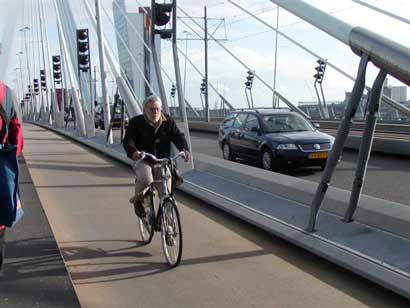
could be in store for a new I-5 bridge.
(More photos below. Photos by Todd Boulanger)
Todd Boulanger is a Senior Transportation Planner with the City of Vancouver (WA). But that’s just his day job. He’s known in the bike scene as a cross-cultural bike-fun ambassador and an Alice Award winner (2005), who also happens to be an expert on bicycle and pedestrian facilities around the world.
Luckily for us, he’s sharing that expertise with Columbia River Crossing staff as a member of the project’s Bicycle and Pedestrian Advisory Committee.
Yesterday Todd sent me a few photos he snapped during a trip with Commissioner Sam Adams and PDOT staff to The Netherlands back in 2006.
Todd says he took the photos of a bridge in Rotterdam specifically for design discussions for a new Interstate Bridge. According to Todd, this type of bike/ped facility could be a viable design for the replacement bridge option.
Here are a few more shots of the bridge…
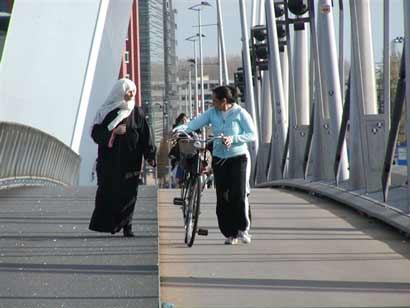
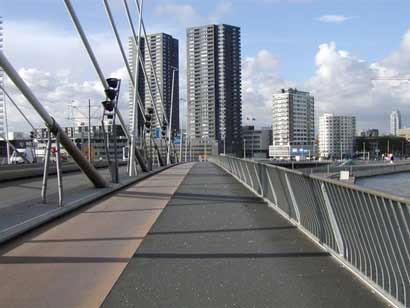
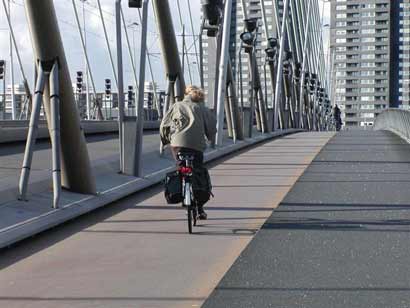



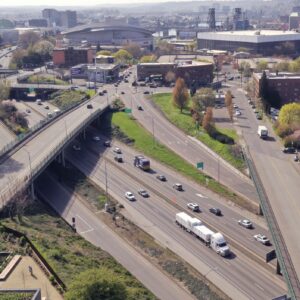
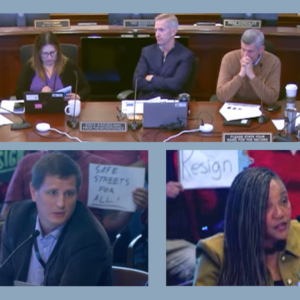
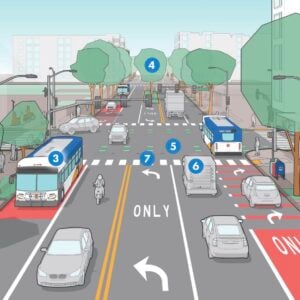

Thanks for reading.
BikePortland has served this community with independent community journalism since 2005. We rely on subscriptions from readers like you to survive. Your financial support is vital in keeping this valuable resource alive and well.
Please subscribe today to strengthen and expand our work.
Here\’s a couple of other photos of bridges in Cologne, Germany. These are not as elegant or beefy as the Rotterdam photos. But, they\’re the same concept and made for an incredibly comfortable trip across the bridges.
The Tram in the photo is a pedestrian tram that connected two linear parks that ran the entire length of the river through the whole city:
http://www.flickr.com/photos/84977575@N00/1174977664/in/set-72157601548535730/
This one hung off the side of a large rail bridge that looks a lot like a big version of the Broadway Bridge.
http://www.flickr.com/photos/84977575@N00/1174976792/in/set-72157601548535730/
By the way, the one with the tram in it is not an interstate type facility. I would definitely want a beefier barrier like the one in the Rotterdam bridge in the interstate setting. These photos are, to me, more about the general set-up of the structure.
That looks like it might be the Erasmus bridge by the UN studio? I think it would be great to get a world class design like that for the Columbia Crossing. I would be tempted to ride it just for fun. It would be fun to experience a bridge ride similar to the Fremont Bridge more frequently then the annual bridge pedal. If we\’re spending the money anyway, it may as well be awesome.
I love the idea of an uber pedestrian and bike friendly facility that is also really aesthetically and architecturally pleasing. Hopefully some creative people will be involved in the design as there are a lot of restraints in the case of the Columbia bridge: needs to be high enough to allow river traffic, low enough (no cables) to allow air traffic for PDX and the historic Pearson Field in Vancouver, plus fit transit (light rail!) and accommodate the traffic.
I like these bridge designs but they are in a setting that seems more urban pedestrian to urban pedestrian. Kind of like the Hawthorne bridge in Portland. I don\’t think our crossing would need as large and segregated pedestrian/bike lane on each side. Perhaps (like the Hawthorne and Steel in PDX) a shared lane on each side about as big as the bike area in these pictures. I do admit though that I have no idea how many people are commuting by bike to Portland. or how many more there would be if there were more room across the Columbia.
Personally I\’d love to see a third bridge for MAX and bikes/pedestrians with local car access to Hayden Island from the OR side. That alone could probably alleviate enough from I5 to clean up the problems with the current bridges for years to come.
Hi Isaac – you have a good eye, yes that is the Erasmus Brug.
http://www.flickr.com/search/?q=Erasmus%20Brug&w=all
The CRC PBAC and staff developed a sheet of multiple \’world class\’ bridges for design discussion. The Erasmus is only 1 of 10 examples. (I am going to approach the CRC staff again to get this document up on the PBAC page. I am not sure why it has not been made more accessible to the public.)
And to Ken…there are about 500 bicyclists a day using the I-5 Bridge (CRC September 2007). This is with the existing conditions…perhaps comparable in [poor] quality to the Hawthorne/ Broadway before they were \’improved\’ and widened for bike and ped traffic. And imagine if existing 250k pedestrians and bicyclists (per year/ NPS data) walking along the Vancouver waterfront trail at the foot of the I-5 Bridge were to then connect to the new \’bridge\’ and cross the river. A \’world class\’ multimodal facility would make this a much more desirable facility.
PS. When looking at the Flickr shots…be aware… that the air traffic police/ FAA will not allow the UDAG (urban design group) to include an iconic super structure in the river for the replacement bridge, as they what to keep the river channel open to air traffic.
Perhaps the best we can hope for would be for similar iconic elements are moved to where the bridge lands on both waterfronts – perhaps splitting the north and south bound lanes. This along with the lids/ caps would become bi-state gateways.
PSS. The original Interstate Bridge had some nice pedestrian scale gateways…inscriptions and obelisks, but with the second bridge (1957) they have been diluted in scale.
Oh, man! I drooled all over my keyboard…
Infrastructure like this would be so very nice. I hope we can find the money to pay for it without neglecting our other responsibilities.
-Ian
Just to chime in, the current I-5 bridge would be much improved if the Jantzen Beach interchange were updated to include a pedestrian-bicycle bypass. Negotiating that bit is dangerous and time consuming.
🙂
The Rotterdam bridge certainly looks like one that would inspire pedestrian and cycling use. I wish replacing a perfectly good bridge wasn’t necessary. But if it is to happen, a Max line has to be included and world-class pedestrian infrastructure needs to be there. Downtown Vancouver is already a good pedestrian location. Jantzen Beach and Delta Park is a concentrated area for crowds with the Expo Center, PIR, Portland Meadows and already popular pedestrian locations like Smith and Bybee Lakes and the Marine Drive bike path. It would be great if Jantzen Beach could develop more pedestrian appeal. A Max line already exists to Delta Park so I’m sure high density residences would be part of the pedestrian infrastructure, but that may be some good land use that doesn\’t cause sprawl (I think).
One of my favorite urban loops from Gresham is NW Portland over the St. John’s Bridge to Smith and Bybee Lakes and back on Marine Drive sometimes with a jaunt into Vancouver. The approach to the current I5 Bridge at Jantzen Beach sucks and the bike path on the bridge isn’t great, but it is scenic and drops you in the middle of Vancouver’s quiet and pedestrian friendly downtown festivities.
Just so happens that the CRC is planning to piggyback the Hayden Island \”makeover\” project within the same timeline. The blueprints of the ideas are making their way around the moorage and neighborhood associations lately, and looks like a very impressive undertaking and goal. The timing is all happening at once, and we were told that it\’s been totally coincidental in this case. Hmmmm!..Especially since the Port of Pdx. is ready to take over the west end of the island.
Todd,
This looks a lot like my idea of an arterial bridge with light rail and bike/ped promenade.
Building an arterial bridge downstream from I-5 would allow better operations on the existing freeway bridges by removing substandard on/off ramps.
Remember 1/3 of the traffic on I-5 don\’t want to be there; they are on local trips, but we give them no choice.
The bridge could be paid for with tolls on all Columbia River crossings in the metro area.
Key question…do any of the current CRC bridge options reduced green house gases and meet state mandated global warming targets? The answer has two letters.
Hi Lenny…I have no idea about the carbon issue and the CRC project…other than what I have read on this site.
Yes you are correct about the sample bridge photo…looking like an arterial bridge layout…it is…though I am currently only using it for purposes of the pedestrian and bicycle facilities.
One issue I have heard the two cities chime in on is they are NOT interested in an arterial bridge due to the long term maintenance of it would be their responsibility vs. the DOTs.
This is one of the primary reasons why Vancouver and Multnomah County fount hard to \’sell\’ the original Interstate Bridge to the new DOTs back in the 1920s(or 1930s?). The states did not want to build the first bridge (nor Sam Hill) in the teens, so the locals took the first bond out for it and set up a toll.
OH, I see how this works, throw the cyclists a juicy bone and we\’ll all forget what is really going on here.
Get \’em to build a kick-ass bike/ped bridge ONLY and then my ears will perk up. Until then, it\’s just a pork filled carbon/benzene spew.
That said, Todd, I really appreciate what you are doing here and if we must have this monster built then I hope cyclists do get a juicy bone. So as insurance, please keep on.
I\’m just not ready to roll over yet. This isn\’t just about bikes for me.
Thanks Dan…its not over until they build it and open it (maintenance).
That said…we need all of your interest and comments during the DEIS review period…to keep this thing a \’world class\’ facility for bicyclists and pedestrians, so that at the ribbon cutting and 50 years from then we will all be marveling at the work we did…vs. having to thing about rebuilding it 10 years later after the bike path gets full or dangerous.
(Sadly the Hawthorne is a such a warning, a much better facility than it was before 2000 but it was not built for the use it has now at such an early point in its lifespan…a success of sorts but bittersweet.)
It is totally unhelpful to imply that the CRC will be a \’world class\’ bridge if only we have some wide bike/ped facilities on it.
In the European bridges, do you see 12 lanes of cars and semi trucks driving at 60 miles per hour?
Can you imagine having a conversation with a friend during a casual ride, with that kind of noise and pollution next to you?
I really appreciate that Todd and others are working to ensure we do have the best possible bike facilities on this thing, but at some point the rest of us need to work on ensuring that those 12 car lanes in the middle don\’t get built. Otherwise, we\’ll be paying for it by having to suffer from increased motor traffic on every street in Portland.
Hmm. As someone who has walked over that bridge a couple times, some observations:
-each side of the bridge lets you pedal 1 direction
-car speed limit is 15mph
-the bike & ped areas are wider than for cars
-the I-5 bridge will be what, 80mph on the Washington side?
-there is a streetcar that runs down the middle
-its really cool
-its way cooler than anything we\’ll ever have
sorry to burst your bubble guys. 🙁
Hi Zilfondel,
Yes I was impressed at that bridge too when we visited it. We as a design community are further along than when we started working with the CRC engineers/ consultants.
Do you have any other bridges to suggest we adopt as a model (Europe or Asia)? Any bridges with covered bikeways? (It \’rains\’ a lot here they say.) (We have just heard there is a new covered bike bridge in Vancouver BC to look a=into.)
LOWER INITIAL EXPECTATIONS
The CRC were not originally directed to plan and design a \’world class\’ bike and pedestrian facility – the UDAG, PBAC, and task force members have asked for this. They were originally directed to plan the \’minimum\’ expected facility…~12\’ wide on one side of the replacement bridge for combined bike and ped movements. The dialog has moved forward…
HIGHER PERFORMANCE EXPECTATIONS
The PBAC findings finalized at last week\’s meeting are focusing on establishing convenient and direct multimodal access on both sides of the bridge corridor and potentially as wide as +20\’ (in the case of the cantilevered bridge – replacement sub option) with the shared path – for regional traffic. A narrower walkway would be on the Mt Hood side – for local/ tourist traffic (waterfront to waterfront).
Wow, cool. Like Rotterdam, our bridge will be useful for people on bikes and not just Cyclists? What fun it would be to bike over the bridge, fearlessly actually looking around, enjoying the view instead of tensed up, staring straight ahead in constant preparation for someone flying up from behind, clipping my handlebars on the way past.
Whether a massive CRC (Columbia River Catastrophe) bridge conforms to 2050 goals for reduction of greenhouse gases should be front and center at tomorrow\’s Global Warming teach-in at University of Portland. The Governor will be there.
The fact is none of the current options conform; they should all be shelved. Better to spend another $50 Million to get it right than to spend $4.5 Billion and get it wrong.
If motorist behavior is any indicator, creating increased bike/ped capacity along the I-5 corridor will lead to an increase in demand for that supply. I can hear the oilboys now:
\”Wut? Yer jess gonna give \’em, like, two car lanes worth? Thas\’ ridiculous! It\’s just gonna excasturbate the sicheeation!\”
Interesting to note that the Sellwood Bridge options all include at least 20 feet of shared bike/pedestrian space. Most options include additional space, either via on-roadway bike lanes, or wider shared paths.
We (the Community Task Force) were given the existing crossing counts, plus some pretty impressive forecasts for bike and pedestrian crossings of the bridge. We didn\’t want to see it \”undersized\” as the Hawthorne and Steel Bridge/Esplanade crossings are turning out to be.
It looks like the CRC is proposing, in general, less bike/ped space than on the Sellwood.
A clarification in my post #6 above, I incorrectly combined two sets of CRC data…Zac Horowitz of the CRC was kind enough to mention this to me today:
\”I’d like to point out a small discrepancy in numbers regarding bike counts on the current I-5 bridge. As you pointed out, we conducted counts in Sept. 2007.\”
\”But, our data showed that there are only 300 cyclists using the I-5 Bridge (14-hour count, 6am-8pm), not 500 as you posted. Not a huge difference, but certainly a substantial one.\”
\”The 500 figure refers to the total count on both the I-5 and I-205 bridges.\”